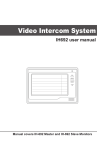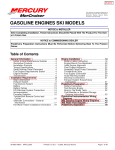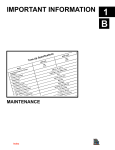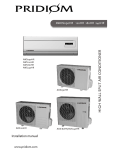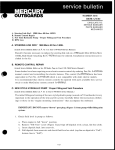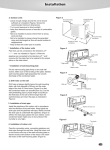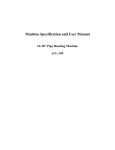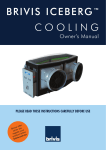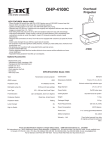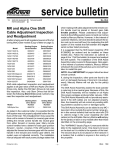Download Predelivery Preparation
Transcript
Predelivery Preparation Predelivery Preparation Section 10A - Predelivery Preparation Table of Contents Predelivery Inspection....................................10A-2 Operating Engine With the Boat out of the Water .......................................................................10A-2 Boat In The Water Tests................................10A-3 Engine Idle Speed..................................10A-3 Wide Open Throttle Test.........................10A-4 Propeller Selection.........................................10A-4 Selection Procedure...............................10A-4 Cruising RPM..........................................10A-6 Priming Fuel System .....................................10A-6 How Elevation and Climate Affect Performance .......................................................................10A-7 Power Package Preparation for Shipment.....10A-7 Extended Storage...................................10A-7 Draining the Cooling System..................10A-8 Engine Corrosion Protection...................10A-9 Disconnecting the Battery.......................10A-9 Disconnecting the Propeller Shaft Coupling ................................................................10A-9 Predelivery Inspection Checklist...........10A-10 10 A 90-863758070 APRIL 2008 Page 10A-1 Predelivery Preparation Predelivery Inspection It is the boat manufacturer's responsibility to perform the checks called out on the checklist included in the literature packet with each engine (see the copy at the end of this section) to verify that the power package has been properly installed and is performing correctly. Each check on the list should be checked‑off to indicate to the dealer and customer that it has been completed. Some of the checks may require that you consult the installation manual or the Operation, Maintenance, and Warranty manual for specific information or procedures. NOTICE Operating the engine out of the water at high speeds creates suction, which can collapse the water supply hose and overheat the engine. Do not operate the engine above 1400 RPM out of the water and without sufficient cooling water supply. If for some reason it is not possible to perform some of the checks at your facility (i.e. performance checks), arrangements should be made with the dealer to ensure that these checks are completed before delivering the boat to the customer. Financial compensation to the dealer for performing these checks is left up to the discretion of the boat manufacturer. Once the checks are completed, the power package must be prepared for shipment. Operating Engine With the Boat out of the Water ! WARNING Performing tests with the engine running may cause the propeller to rotate and result in serious injury or death. Use caution when performing a test that requires the engine running, and remove the propeller to avoid injury. NOTICE Without sufficient cooling water, the engine, the water pump, and other components will overheat and suffer damage. Provide a sufficient supply of water to the water inlets during operation. Page 10A-2 90-863758070 APRIL 2008 Predelivery Preparation 1. Disconnect the water inlet hose for the seawater pickup pump. Connect the water hose using appropriate hardware. a a 7638 Typical composite seawater pump a - Seawater inlet hose 9361 Typical brass seawater pump NOTICE To properly purge water from the exhaust system, the engine must be running. Failure to provide adequate exhaust flow can introduce water into the muffler or engine, leading to severe equipment damage. When operating an engine with the boat out of the water, always start the engine immediately after introducing flushing water to the system. 2. Partially open the water tap (approximately 1/2 capacity). DO NOT exceed 276 kPa (40 psi). NOTICE Operating the engine out of the water at high speeds creates suction, which can collapse the water supply hose and overheat the engine. Do not operate the engine above 1400 RPM out of the water and without sufficient cooling water supply. 3. Place the remote control in NEUTRAL, idle speed position and start the engine. 4. Operate the engine in NEUTRAL (out of gear) between 1200–1400 RPM. 5. Closely monitor water temperature gauge to ensure that engine does not overheat. Boat In The Water Tests Engine Idle Speed Engine should idle at RPM as specified in appropriate Mercury MerCruiser Operation, Maintenance, and Warranty Manual with boat in the water, drive unit in FORWARD gear and engine at normal operating temperature. If idle speed is incorrect, proceed as follows: 1. Ensure that throttle cable has been adjusted properly. 2. If idle is still not correct, it may be necessary to perform EFI System Diagnostic Tests on the idle circuit. Refer to the appropriate Mercury MerCruiser Service Manual for procedures. 90-863758070 APRIL 2008 Page 10A-3 Predelivery Preparation Wide Open Throttle Test IMPORTANT: To operate engine at full throttle before the break‑in period is complete, follow this procedure. 1. Place remote control in neutral , idle speed and start engine. 2. Slowly advance throttle until engine reaches 1300 rpm (+/‑100 rpm). 3. Watch all gauges for normal readings. 4. When engines reaches mornal operating temperature, run the boat up on plane. 5. Advance engine RPM (in 200 RPM increments) until engine reaches its maximum rated RPM. 6. To test if the correct propeller has been installed, operate boat (with normal load on board) at WOT and check RPM with an accurate tachometer. Engine RPM should be near top of the specified range so that, under a heavy load, engine speed will not fall below specifications. If engine speed is too high, replace propeller with a higher pitch propeller. Normally a 25 mm (1 in.) propeller pitch change causes an RPM change of 150 RPM. 7. Return to idle speed. 8. Shut off engine. 9. Check coolant level and add coolant if necessary. Propeller Selection A book called Everything You Need to Know About Propellers (90‑86144‑‑92) is available from Mercury Precision Parts and Accessories. This full‑color book provides the latest in propellers, how they work, types, design and manufacturing, how to select the proper propeller for a given application, and answers to many commonly asked questions about boating performance. Selection Procedure NOTICE Operating the engine with the wrong propeller installed can limit power, increase fuel consumption, overheat the engine, or cause internal powerhead damage. Choose a propeller that allows the engine to operate at the specified wide open throttle RPM. It is the responsibility of the boat manufacturer and/or the selling dealer to equip the power package with the correct propeller. Select a propeller that will allow the engine to operate at the maximum RPM of the engine's specified wide open throttle (WOT) RPM range. (See Section 1 - Important Information for specifications). Use an accurate service tachometer to verify RPM. Page 10A-4 90-863758070 APRIL 2008 Predelivery Preparation Using a propeller that does not allow the engine to operate within the specified WOT RPM range can cause detonation or pre‑ignition damage to the engine (even if the engine is not operated at WOT). Using a propeller that allows the engine to operate above the specified maximum RPM will cause higher than normal wear or damage. A lower pitch or smaller diameter propeller must be used if RPM is too low, while a higher pitch or larger diameter must be used if RPM is too high. 14394 Detonation Pre-Ignition Example: Prop the engine as close to 4800 RPM as possible on an engine with a specified WOT RPM range of 4400–4800. When selecting the propeller, the boat should be loaded as outlined below. Weights can be used to simulate the load. Loading the boat in this manner will help to ensure that the RPM do not fall below the specified range when a heavy load is placed aboard by the operator. 1. Half‑full fuel tanks 2. Full water tanks (if equipped) 3. Four people in seats at helm and stern (equally distributed) Equivalent Weights 1 person + gear 86 kg (190 lbs) 1 US gallon gasoline 0.72 kg (6 lbs) 1 US Gallon Water 1 kg (8.3 lbs) Select model and initial pitch propeller to begin testing with using information provided in the Mercury Precision Parts and Accessories Guide. A vast array of propeller models and pitches are available to suit virtually any boat application. Initial selection is typically done by boat weight. Operate boat at wide open throttle and adjust power trim to achieve optimum speed without using excessive trim. If RPM is above the specified range, a higher pitch propeller must be used. A lower pitch propeller must be used if RPM is too low. There is typically a 200–300 RPM change for every 2 in. change in propeller pitch. Engines are equipped with an RPM rev‑limiter. The rev‑limiter is set slightly above the specified WOT range of the engine and is designed to help prevent damage from a temporary excessive engine RPM condition. Do not operate above the rev‑limiter continuously. When rev‑limiter is activated, the engine will appear to have a misfire. Once the RPM drops into the specified operating RPM range, normal engine operation resumes. On carbureted engines with Thunderbolt V Ignition, service (or boat) tachometer is not able to give an accurate RPM reading when the rev‑limiter is activated. For better acceleration, such as is needed for water skiing, the next lower pitch propeller can be used. Care must be exercised when not pulling skiers to prevent over‑revving the engine. When cruising, the next highest pitch propeller should be used. 90-863758070 APRIL 2008 Page 10A-5 Predelivery Preparation The owner should be advised to recheck the WOT RPM after the first 50 hours of operation to ensure that it is still within the specified range. IMPORTANT: The correct propeller must be used for optimum boat performance and engine life. Because of the many variables of boat design, only testing will determine the best propeller for a particular application. The following factors may also cause a loss of engine RPM and require the use of a lower pitch or smaller diameter propeller: 1. Warmer weather and greater humidity. 2. Operating in a higher elevation. 3. Operating with a damaged propeller or dirty boat bottom. 4. Operating with increased loads (accessories added). Cruising RPM Modern inboard engines operate at higher engine speeds than those produced just a few years ago. This increased RPM along with better breathing is largely responsible for the significant increase in horsepower of these new engines. Along with the higher WOT RPM comes higher cruising RPM. This higher RPM is critical for optimum performance and efficiency. The materials and design of the new engines allow these higher speeds without a durability penalty. In fact, over‑propping the boat to reduce the cruising RPM to previous levels will increase the susceptibility to engine damage from detonation and pre‑ignition. The recommended cruising RPM ranges are listed in the following table. Cruising RPM for Peak Efficiency Model RPM Range 5.7 TKS Inboard 3200–3600 5.7 MPI 3400–3800 Horizon 5.7 3400–3800 Scorpion 350 3600–3800 6.2 MPI 3600–4000 Scorpion 377 3600–4000 Horizon 8.1 3200–3600 8.1 H.O. 3400–3800 Priming Fuel System New engines are shipped from the factory with the fuel system dry. During initial start up, the engine is often difficult to start and keep running. Also, the electric fuel pump relies on gasoline to lubricate it while running. Priming the fuel system before starting the engine will make it start quicker and avoid problems due to lack of lubrication. To prime the fuel system, use a small, portable outboard fuel tank with a primer bulb fuel line. ! WARNING Fuel is flammable and explosive. Ensure the key switch is off and the lanyard is positioned so that the engine cannot start. Do not smoke or allow sources of spark or open flame in the area while servicing. Keep the work area well ventilated and avoid prolonged exposure to vapors. Always check for leaks before attempting to start the engine and wipe up any spilled fuel immediately. 1. Disconnect and plug the boat's fuel line from the fuel inlet fitting. Page 10A-6 90-863758070 APRIL 2008 Predelivery Preparation 2. Attach the outboard fuel tank with primer bulb fuel line to the fitting and secure tightly. 3. Squeeze the primer bulb until the bulb becomes firm. 4. Turn the ignition switch to the RUN position for three seconds and then turn OFF. NOTE: Do not turn the key switch to the `START' position during the priming. 5. Repeat steps 3 and 4 three more times. IMPORTANT: Before disconnecting the fuel line primer bulb, make sure the bulb is "soft" to prevent spilling fuel. 6. Disconnect the primer bulb fuel line from the fitting. Reconnect the boat's fuel line and tighten securely. 7. Start the engine and let it idle for three minutes. Do not advance the throttle during this idle time. How Elevation and Climate Affect Performance Elevation has a noticeable effect on the wide open throttle power of an engine. Since air gets thinner as elevation increases, the engine begins to starve for air. Humidity, barometric pressure, and temperature have a noticeable effect on the density of air; heat and humidity thin the air. This condition can become particularly bothersome when the propeller testing is done on a cool, dry day, then later on a hot, sultry day and the boat does not seem to have the same performance. Although some performance can be regained by dropping to a lower pitch propeller, the basic problem still exists. In some cases, a gear ratio change to more reduction is possible and very beneficial. Summer conditions of high temperature, low barometric pressure, and high humidity all combine to reduce the engine power. This, in turn, is reflected in decreased boat speeds, as much as 2 or 3 miles per hour in some cases. In pointing out the practical consequences of weather effects, an engine running on a hot, humid, summer day, may encounter a loss of as much as 14% of the horsepower. With the drop in available horsepower, this propeller will, in effect, become too large. Consequently, the engine operates at less than its recommended RPM. This will result in further loss of horsepower at the propeller with another decrease in boat speed. This secondary loss, however, can be somewhat regained by switching to a lower‑pitch propeller that allows the engine to again run at recommended RPM. For boaters to realize optimum engine performance under changing weather conditions, it is essential that the engine be propped to allow it to operate at or near the top end of the recommended maximum RPM range at wide open throttle with a normal boat load. Not only does this allow the engine to develop full power, but the engine will also be operating in an RPM range that discourages detonation. This enhances overall reliability and durability of the engine. Power Package Preparation for Shipment Extended Storage If the boat will not be operated for more than a month, the engine should be prepared for extended storage as outlined in the owner's operation, maintenance, and warranty manual. This is particularly important to protect the internal surfaces of the engine against corrosion and to avoid fuel system problems due to fuel decomposition. Preparation for extended storage requires the following products. See Section 1 for part numbers. • • Quicksilver 2‑Cycle Outboard Oil (required for EFI / MPI models only) Quicksilver Gasoline Stabilizer for Marine Engines 90-863758070 APRIL 2008 Page 10A-7 Predelivery Preparation • Quicksilver Storage Seal (required for carbureted models only) ! WARNING Fuel is flammable and explosive. Ensure the key switch is off and the lanyard is positioned so that the engine cannot start. Do not smoke or allow sources of spark or open flame in the area while servicing. Keep the work area well ventilated and avoid prolonged exposure to vapors. Always check for leaks before attempting to start the engine and wipe up any spilled fuel immediately. ! CAUTION Failure to release pressure from the fuel system will result in fuel spraying out, which can cause a fire or explosion. Allow the engine to cool completely and release all fuel pressure before servicing any part of the fuel system. Always protect eyes and skin from pressurized fuel and vapors. NOTICE Without sufficient cooling water, the engine, the water pump, and other components will overheat and suffer damage. Provide a sufficient supply of water to the water inlets during operation. NOTICE Running out of fuel can damage catalyst components. Do not allow the fuel tanks to become empty during operation. Draining the Cooling System NOTICE Water trapped in the seawater section of the cooling system can cause corrosion or freeze damage. Drain the seawater section of the cooling system immediately after operation or before any length of storage in cold weather. If the boat is in the water, keep the seacock closed until restarting the engine to prevent water from flowing back into the cooling system. If the boat is not fitted with a seacock, leave the water inlet hose disconnected and plugged. Protect the engine against corrosion and freeze damage. Flush and drain all water from the engine cooling system after performing the Predelivery Inspection Checklist. The cooling system should be drained prior to shipment even during warm temperature periods. This will avoid controversies with your dealers as to who is responsible for any freeze damage problems that may occur due to the engine not getting drained prior to shipment at Mercury MerCruiser as well as at your facility. Specific flushing and draining instructions are provided in the Operation, Maintenance and Warranty manual that accompanies each engine. On closed cooled models, only the seawater section of closed cooling system need be drained provided that the proper mixture of antifreeze and water is used in the closed cooling section to protect engine to lowest temperature to which it will be exposed. Do not forget to drain the sea strainer and mufflers (if applicable), which are not included in our draining instructions. IMPORTANT: The boat must be as level as possible to ensure complete draining of the cooling system. Page 10A-8 90-863758070 APRIL 2008 Predelivery Preparation IMPORTANT: Mercury MerCruiser recommends that propylene glycol (a nontoxic and environmentally safe) antifreeze be used in the seawater section of the cooling system as an additional measure against corrosion and freeze damage. Make sure that propylene glycol antifreeze contains a rust inhibitor and is recommended for use in marine engines. Be certain to follow the antifreeze manufacturer's recommendations. Engine Corrosion Protection All engines that will be subjected to a corrosive environment during shipment should be sprayed with Corrosion Guard. Corrosion Guard is specially formulated to provide a protective barrier against the corrosive elements to keep the power package looking like new. Refer to application instructions on the Corrosion Guard container. Disconnecting the Battery All battery cables should be disconnected from battery for shipment. Some regulations require that the battery be shipped dry (without electrolyte). Check applicable regulations. Disconnecting the Propeller Shaft Coupling IMPORTANT: Prevent shipping damage to the propeller shaft and transmission. Disconnect the coupling before packing. On applications with a rigid propeller shaft coupling, the coupling must be disconnected from the transmission flange before boat is removed from the water for shipment. Coupling should not be reconnected until the boat is in the water at its final destination and the engine alignment has be rechecked. Some misalignment may occur during transit, particularly on large boats. a 50608 a - Typical rigid propeller shaft coupling 90-863758070 APRIL 2008 Page 10A-9 Predelivery Preparation Predelivery Inspection Checklist Not Applicable Check / Adjust Not Applicable Check / Adjust ⃞ ⃞ Drain plug in and petcocks closed ⃞ ⃞ Engine alignment (Inboards only) ⃞ ⃞ Seawater inlet valve open ⃞ ⃞ Starter neutral safety switch operation ⃞ ⃞ Engine mounts tight ⃞ ⃞ Water pump operation ⃞ ⃞ Engine alignment ⃞ ⃞ Instrument(s) operation ⃞ ⃞ Sterndrive or transmission fasteners torqued ⃞ ⃞ Fuel leaks ⃞ ⃞ Power trim cylinders fasteners tight ⃞ ⃞ Oil leaks ⃞ ⃞ Battery fully charged and secured ⃞ ⃞ Water leaks ⃞ ⃞ All electrical connections tight ⃞ ⃞ Exhaust leaks ⃞ ⃞ Exhaust system hose clamps tight ⃞ ⃞ Ignition timing ⃞ ⃞ All fuel connections tight ⃞ ⃞ Idle________ RPM, within specifications ⃞ ⃞ Correct rotation propeller (installed and torqued) ⃞ ⃞ Forward ‑ Neutral ‑ Reverse gear operation ⃞ ⃞ Throttle, shift and steering system fasteners tightened properly ⃞ ⃞ Steering operation throughout range ⃞ ⃞ Throttle plates open and close completely ⃞ ⃞ Acceleration from idle RPM ⃞ ⃞ Crankcase oil level ⃞ ⃞ WOT________ RPM within specifications (in FORWARD gear) ⃞ ⃞ Power trim oil level ⃞ ⃞ Power trim operation ⃞ ⃞ Sterndrive oil level ⃞ ⃞ Trim tab adjustment ⃞ ⃞ Power steering fluid level ⃞ ⃞ Boat handling ⃞ ⃞ Closed cooling level ⃞ ⃞ Transmission fluid level ⃞ ⃞ Propeller nut torque ⃞ ⃞ Alternator belt tension ⃞ ⃞ Fuel, oil, coolant, water and fluid leaks ⃞ ⃞ Seawater pickup pump belt tension ⃞ ⃞ Oil and fluid levels ⃞ ⃞ Power steering pump belt tension ⃞ ⃞ Apply Quicksilver Corrosion Guard to engine package ⃞ ⃞ Audio warning system operation ⃞ ⃞ C.A.R.B. Hang Tag and Owners Manual in boat (If registered to a CA resident.) ⃞ ⃞ C.A.R.B. Decal properly affixed to boat hull (If registered to a CA resident.) Page 10A-10 CHECK BEFORE RUNNING ON THE WATER TEST AFTER ON WATER TEST 90-863758070 APRIL 2008











